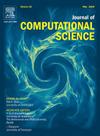A cluster-based opposition differential evolution algorithm boosted by a local search for ECG signal classification
IF 3.7
3区 计算机科学
Q2 COMPUTER SCIENCE, INTERDISCIPLINARY APPLICATIONS
引用次数: 0
Abstract
Electrocardiogram (ECG) signals, which capturethe heart's electrical activity, are used to diagnose and monitor cardiac problems. The accurate classification of ECG signals, particularly for distinguishing among various types of arrhythmias and myocardial infarctions, is crucial for the early detection and treatment of heart-related diseases. This paper proposes a novel approach based on an improved differential evolution (DE) algorithm for ECG signal classification for enhancing the performance. In the initial stages of our approach, the preprocessing step is followed by the extraction of several significant features from the ECG signals. These extracted features are then provided as inputs to an enhanced multi-layer perceptron (MLP). While MLPs are still widely used for ECG signal classification, using gradient-based training methods, the most widely used algorithm for the training process, has significant disadvantages, such as the possibility of being stuck in local optimums. This paper employs an enhanced differential evolution (DE) algorithm for the training process as one of the most effective population-based algorithms. To this end, we improved DE based on a clustering-based strategy, opposition-based learning, and a local search. Clustering-based strategies can act as crossover operators, while the goal of the opposition operator is to improve the exploration of the DE algorithm. The weights and biases found by the improved DE algorithm are then fed into six gradient-based local search algorithms. In other words, the weights found by the DE are employed as an initialization point. Therefore, we introduced six different algorithms for the training process (in terms of different local search algorithms). In an extensive set of experiments, we showed that our proposed training algorithm could provide better results than the conventional training algorithms.
基于集群的对立微分进化算法,通过局部搜索进行心电信号分类
捕捉心脏电活动的心电图(ECG)信号被用来诊断和监测心脏问题。心电信号的准确分类,特别是区分各种类型的心律失常和心肌梗死,对于心脏相关疾病的早期发现和治疗至关重要。为了提高心电信号的分类性能,提出了一种基于改进差分进化算法的心电信号分类方法。在我们方法的初始阶段,预处理步骤之后是从心电信号中提取几个重要特征。然后将这些提取的特征作为输入提供给增强型多层感知器(MLP)。虽然mlp仍然被广泛用于心电信号分类,但使用基于梯度的训练方法作为训练过程中使用最广泛的算法,存在明显的缺点,例如可能陷入局部最优。本文采用一种增强的差分进化(DE)算法作为训练过程中最有效的基于种群的算法之一。为此,我们基于聚类策略、基于对立的学习和局部搜索改进了DE。基于聚类的策略可以作为交叉算子,而对立算子的目标是提高DE算法的探索性。然后将改进DE算法得到的权重和偏差输入到六种基于梯度的局部搜索算法中。换句话说,DE找到的权重被用作初始化点。因此,我们在训练过程中引入了六种不同的算法(根据不同的局部搜索算法)。在大量的实验中,我们证明了我们提出的训练算法可以提供比传统训练算法更好的结果。
本文章由计算机程序翻译,如有差异,请以英文原文为准。
求助全文
约1分钟内获得全文
求助全文
来源期刊

Journal of Computational Science
COMPUTER SCIENCE, INTERDISCIPLINARY APPLICATIONS-COMPUTER SCIENCE, THEORY & METHODS
CiteScore
5.50
自引率
3.00%
发文量
227
审稿时长
41 days
期刊介绍:
Computational Science is a rapidly growing multi- and interdisciplinary field that uses advanced computing and data analysis to understand and solve complex problems. It has reached a level of predictive capability that now firmly complements the traditional pillars of experimentation and theory.
The recent advances in experimental techniques such as detectors, on-line sensor networks and high-resolution imaging techniques, have opened up new windows into physical and biological processes at many levels of detail. The resulting data explosion allows for detailed data driven modeling and simulation.
This new discipline in science combines computational thinking, modern computational methods, devices and collateral technologies to address problems far beyond the scope of traditional numerical methods.
Computational science typically unifies three distinct elements:
• Modeling, Algorithms and Simulations (e.g. numerical and non-numerical, discrete and continuous);
• Software developed to solve science (e.g., biological, physical, and social), engineering, medicine, and humanities problems;
• Computer and information science that develops and optimizes the advanced system hardware, software, networking, and data management components (e.g. problem solving environments).
 求助内容:
求助内容: 应助结果提醒方式:
应助结果提醒方式:


